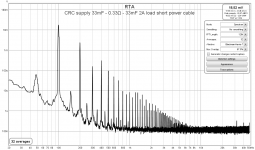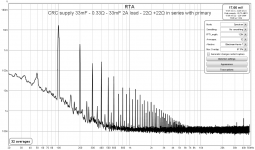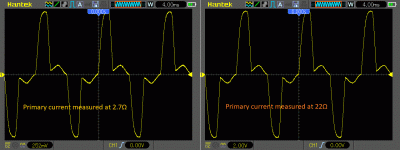It doesn't work like that. The diodes interact with the secondary winding. A snubber across the secondary deals with that. Done.This quote is from the Shunyata web site.
"A primary source of audible sonic degradation is caused by the power supplies. Most components use FWBR (full wave bridge rectifier) power supplies that generate an incredible amount of transient noise when the rectifiers switch on and off. The design of a power cord can significantly affect the reactance of these signals within the power supply. Because the power cord is part of the primary winding of the power transformer,
Shunyata wants to get the noise inside the equipment out and away from the equipment through the power cord.
Btw: said snubber needs to be designed to match the parasitics of said secondary winding.
More information for you. Has anyone tried to measure power line noise, and if so what were your measurements?
I had some free time to check if another wild theory holds. In any cables thread, they are growing better than mushrooms after rain. 😀
Rail harmonics were measured at simple CRC power supply connected to mains with short cable and no filters. Another measurement was made with two 22Ω resistors added to both primary wires. If low power cable impedance enables harmonics and noise to be damped by allegedly low power network impedance, then inserting such high resistance should make harmonics and noise to increase.
There is no meaningful difference. Small differences are due small variations in mains voltage and noise over time and different moment of taking measurement. Transformer primary current waveform doesn’t change as well.
When thinking, ‘where could harmonics go’ it is better to understand that measured harmonics don’t exist as a separate from the main 100 Hz waveform charging PS capacitors. They are simply deviation of main 100 Hz charging voltage/current, from the ideal sinewave. So, all harmonics go to PS capacitors and circuit supplied by PS.
Harmonics would change if power supply cable can change shape of voltage/current flowing to PS capacitors and load.
Now where is this noise going to go? It is going to want to take the path out out of the equipment thru the power cord to the point of lowest impedance, the power company. Where else is it going to go?
Rail harmonics were measured at simple CRC power supply connected to mains with short cable and no filters. Another measurement was made with two 22Ω resistors added to both primary wires. If low power cable impedance enables harmonics and noise to be damped by allegedly low power network impedance, then inserting such high resistance should make harmonics and noise to increase.
There is no meaningful difference. Small differences are due small variations in mains voltage and noise over time and different moment of taking measurement. Transformer primary current waveform doesn’t change as well.
When thinking, ‘where could harmonics go’ it is better to understand that measured harmonics don’t exist as a separate from the main 100 Hz waveform charging PS capacitors. They are simply deviation of main 100 Hz charging voltage/current, from the ideal sinewave. So, all harmonics go to PS capacitors and circuit supplied by PS.
Harmonics would change if power supply cable can change shape of voltage/current flowing to PS capacitors and load.
Attachments
Re tombo56 posts #107 and #183:
Thanks for providing some actual data to discuss. Particularly post #183 where data on the actual power line is measured. Do you think that if you added a “noise source” (1/2 to 1 HP motor, light dimmers, hot air guns) to the power line feeding your CRC power supply you would be able to detect any changes to the distortion spectrum as you tuned them on and off?
Thanks for providing some actual data to discuss. Particularly post #183 where data on the actual power line is measured. Do you think that if you added a “noise source” (1/2 to 1 HP motor, light dimmers, hot air guns) to the power line feeding your CRC power supply you would be able to detect any changes to the distortion spectrum as you tuned them on and off?
Yes, there would be very visible changes in noise and harmonics level. Whether that additional nose could be of any significance for circuits down the supply line, is another question.
Note that most of higher frequency harmonics or noise are at 10 uV – 1 uV level. Most audio circuits will not pass noise at their supply rails directly to the output. Power supply noise is attenuated by amplifier PSRR and that is usually from 30 – 100 dB or from 30 – 100.000 times reduction. Attenuation is usually worse at high frequencies.
I use and would recommend good quality RF power inlet module like Schurter, as a mandatory for good DIY builds. They pay off, as is partially visible at post #107.
Note that most of higher frequency harmonics or noise are at 10 uV – 1 uV level. Most audio circuits will not pass noise at their supply rails directly to the output. Power supply noise is attenuated by amplifier PSRR and that is usually from 30 – 100 dB or from 30 – 100.000 times reduction. Attenuation is usually worse at high frequencies.
I use and would recommend good quality RF power inlet module like Schurter, as a mandatory for good DIY builds. They pay off, as is partially visible at post #107.
Such a trivial amount of "noise" levels it would seem would only bother people obsessed with some form of perfection that I suspect only aliens from another planet would worry about.Yes, there would be very visible changes in noise and harmonics level. Whether that additional nose could be of any significance for circuits down the supply line, is another question.
Note that most of higher frequency harmonics or noise are at 10 uV – 1 uV level. Most audio circuits will not pass noise at their supply rails directly to the output.
Or many DIY perfectionists. Aliens for sure.Such a trivial amount of "noise" levels it would seem would only bother people obsessed with some form of perfection that I suspect only aliens from another planet would worry about.
Heck, if I had to worry about and consume so much time worrying over trivialities like this, I'd be a nutcase, dreaming about potential "spikes" and microscopic blips in electrical power grids.Are you sure it's not the aliens that are responsible for the electrical noise? 👽
In all the years of my experience, both domestic and professional, I've never wasted time on such things.
I'd be a nutcase...
I think my noise problem is due to my loudspeakers having a poor ground connection!

Tombo45, I am thinking about this more as an experimental model rather than considering the subjective effects of this “noise” on program material. For example, if we have a reliable and controllable “noise source” and we can measure that noise on the power line, then we have a system for comparing different power cables.
I agree that would be an acceptable method for comparison.
Problem is reliable noise source that doesn’t change from one to another measurement. I can plug in a hair dryer or electric drill, but they produce noise that varies and depends on AC voltage (rotation speed), commutator wear, air humidity and what not.
IMO, differences introduced by different cables would be so small, that noise source should be extraordinary stable.
Problem is reliable noise source that doesn’t change from one to another measurement. I can plug in a hair dryer or electric drill, but they produce noise that varies and depends on AC voltage (rotation speed), commutator wear, air humidity and what not.
IMO, differences introduced by different cables would be so small, that noise source should be extraordinary stable.
While test equipment wise it could be a real challenge.
Measuring low frequency power line noise current is much more reveling than noise voltage.
Measuring low frequency power line noise current is much more reveling than noise voltage.
In this video he uses a paper shredder as a noise source.
My BS meter didn’t just go through roof, but went further than Artemis mission. 🤣
First there was some ‘noise meter’ with unspecified measurement units and bandwidth, presenting us with all that
Now, we have another made up example, where mandatory noise suppression components were obviously removed from the paper shredder.
I plugged very similar shredder to socket next to power supply plug and measured noise with shredder on. Only difference was at 50 Hz as magnetic fields from motor were 50 cm apart from the measurement cables and gear.
You can accuse me of not knowing how to make proper measurements, unlike those
To be clear, I’m sure their products successfully reduce noise from mains. It’s not a high science.
Last edited:
An RF spectrum analyzer should probably be used to check for higher frequency noise presence. Only point is that whatever noise is actually on the line should reasonably be measured to start with, if possible. That might give some hints as to what sorts of downstream problems might be checked for.
I agree that home runs are a good idea. I think his story about hearing the differences in cables and things we once did not know about like bacteria is good.
- Status
- Not open for further replies.
- Home
- Member Areas
- The Lounge
- Power Conditioners and Cords



